
• Main Page
- • Home
• Antennas
- • 432 MHz
- YBN 70-5m
A 0.5 m 432 MHz blue print of the YBN 2-5m 50 ohms
high F/B direct feed 144 MHz Low Noise Yagi 3D Plot

- YBN 70-8z
A 1.5 m high gain 28 ohms Yagi. A design partly based on the hardware of the WY-7010,
turning it into a 8 ele. 28 ohms Yagi with cleaner pattern, +1.8 dB gain and better VSWR. Azimuth Plot

- YBN 70-14wz
Tune up your 19 ele. Tonna!A design based on the hardware of the F9FT,
turning it into a 14 ele. OWL with cleaner pattern, +0.3 dB gain and SWR less than 1.2 from 430 to 440 MHz Azimuth Plot

- YBN 70-14+4w
A 3.2 m very wideband 50 ohms Yagi with reflector wall
that covers the whole 70 cm band with ease Elevation Plot

- GTV 70-2w
A 0.14 m GTV useful for portable operation and up to the satellit band
and handheld activities of any kind Elevation Plot

- GTV 70-3w
A 0.21 m GTV useful for portable operation and up to the satellit band
and lower noise stacks of any kind Elevation Plot

- GTV 70-4m
A 0.34 m GTV useful for portable operation up to the satellit band
and lower noise stacks of any kind Elevation Plot

- GTV 70-7w
A 0.96 m GTV useful for portable operation up to the satellit band
and lower noise stacks of any kind Elevation Plot

- GTV 70-7n
A 1.1 m 432 MHz blue print of the low impedance, yet 50 ohms
direct feed 144 MHz Low Noise Yagi introduced in Dubus 1/2013 Elevation Plot
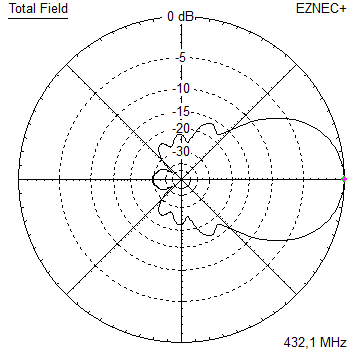
- GTV 70-8n
A 1.3 m 432 MHz GTV with high gain but low backlobe volume. Makes
a very compact 4 Yagi bay for QRP EME or contesting.
Elevation Plot
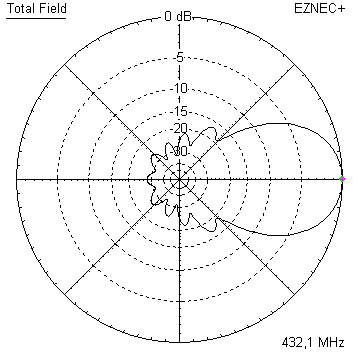
- GTV 70-9w
A 1.44 m GTV ment to be useful as a vertical stack for contesting
or be an ideal small size portable Yagi Elevation Plot

- GTV 70-10w
A 1.63 m GTV useful for portable operation up to the satellit band
and lower noise stacks of any kind Elevation Plot
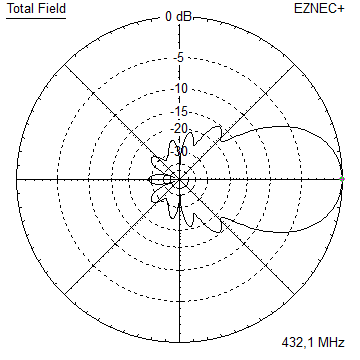
- GTV 70-11w
A 2.01 m GTV ment to be useful as a vertical stack for contesting
or be an ideal small size portable Yagi or minimum size EME 4 bay Elevation Plot
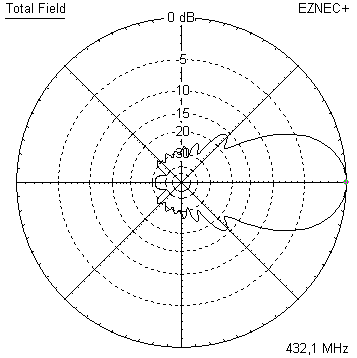
- GTV 70-13m
A 2.5 m GTV ment to be useful as a vertical stack for contesting
or be an ideal small size portable Yagi or minimum size EME 4 bay Elevation Plot

- GTV 70-14m
2.9 m version of the low impedance, yet 50 ohms
direct feed Low Noise Yagi with bent DE introduced in Dubus 1/2013 Elevation Plot
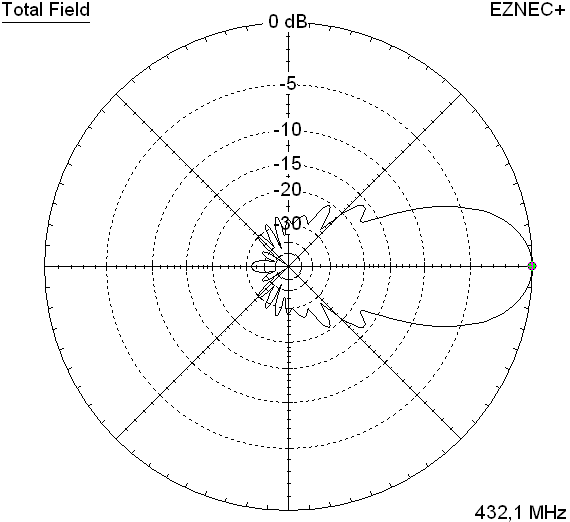
- GTV 70-17m
3.7 m version of the low impedance, yet 50 ohms
direct feed Low Noise Yagi with bent DE introduced in Dubus 1/2013 Elevation Plot

- GTV 70-18w
4.0 m version of the low impedance, yet 50 ohms
direct feed Low Noise Yagi with bent DE introduced in Dubus 1/2013 Elevation Plot
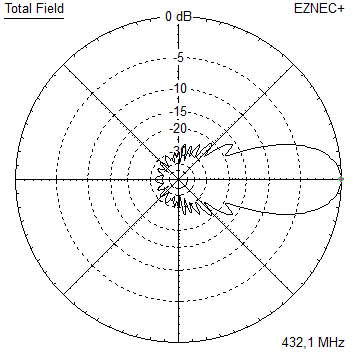
- GTV 70-19m
4.2 m version of the low impedance, yet 50 ohms
direct feed Low Noise Yagi with bent DE introduced in Dubus 1/2013 Elevation Plot

- GTV 70-21n
4.7 m version of the low impedance, yet 50 ohms
direct feed Low Noise Yagi with bent DE introduced in Dubus 1/2013 Elevation Plot

- GTV 70-23m
5.3 m version of the low impedance, yet 50 ohms
direct feed Low Noise Yagi with bent DE introduced in Dubus 1/2013 Elevation Plot
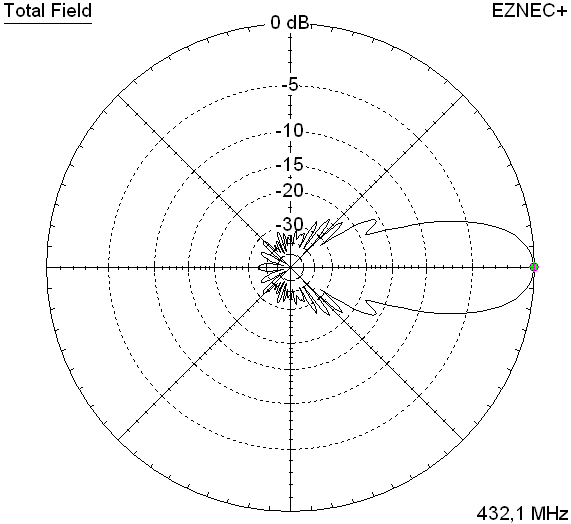
- GTV 70-25m
5.9 m version of the low impedance, yet 50 ohms
direct feed Low Noise Yagi with bent DE introduced in Dubus 1/2013 Elevation Plot

- GTV 70-30m
7.3 m version of the low impedance, yet 50 ohms
direct feed Low Noise Yagi with bent DE introduced in Dubus 1/2013 Elevation Plot
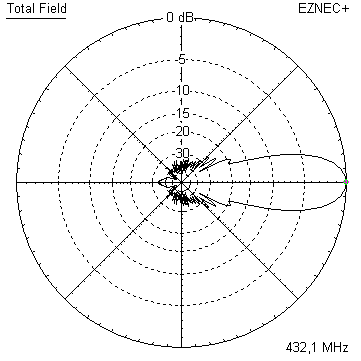
- GTV 70-34w
8.5 m version of the low impedance, yet 50 ohms
direct feed Low Noise Yagi with bent DE introduced in Dubus 1/2013 Elevation Plot
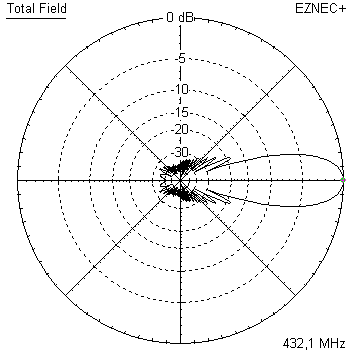
- GTV 70-46w
12.0 m version of the low impedance, yet 50 ohms
direct feed Low Noise Yagi with bent DE introduced in Dubus 1/2013 Elevation Plot

- DL6WU Yagis
The DL6WU Longyagi Series
Sample plot: 32 el. plus 4 x reflector
Elevation Plot

|
....... |
 Performance Data and Geometry Performance Data and Geometry
 Pattern and VSWR Pattern and VSWR
 Stacking Stacking
 Matching Matching
GTV 70-34w Yagi with bent Driven Element
432.1 MHz EME to 436 MHz Longyagi as Wideband Antenna Version (OWA-style)
This Yagi has very low back lobes for its length. It may serve as single antenna for Tropo
or make a nice 4 Yagi EME array. It also makes a quiet contest antenna due to its high F/B.
The bent DE (K6STI style) transforms from approx. 17 ohms to 50 ohms at feed point.
What else? With this Yagi I stopped producing more forward gain keeping the directivity factor
at a point that I see as uncritical still for producing nicely working real world builds.
Antenna G/T can be pushed further but with increase of Antenna Temperature mainly.
Which I did not want to do. In my understanding the 34 element Yagi should not hold a higher
Antenna Temperature than the GTV70-30m.
The GTV70-34w produces a solid 0.5 dB higher G/T compared to the GTV70-30m which by
all means should show in its performance for EME and other Weak Signal operations.
Current distribution


Performance Data
Specs: with 8 mm elements @ 432.1 MHz
Gain vs. isotr. Rad. 20.3 dBi
Gain vs. Dipole 18.2 dBD
-3 dB E-plane 19.6 deg.
-3 dB H-plane 20.0 deg.
F/B -40.5 dB (34 dB)
F/R -33.8 dB
Impedance 50 ohms
Mechan. Length 8455 mm
Electr. Length 12.18 λ
Stacking Dist. h-pol. acc the DL6WU formula
top-to-bottom 1.998 m
side-by-side 2.038 m
Geometry
Geometry for 8 mm elements 
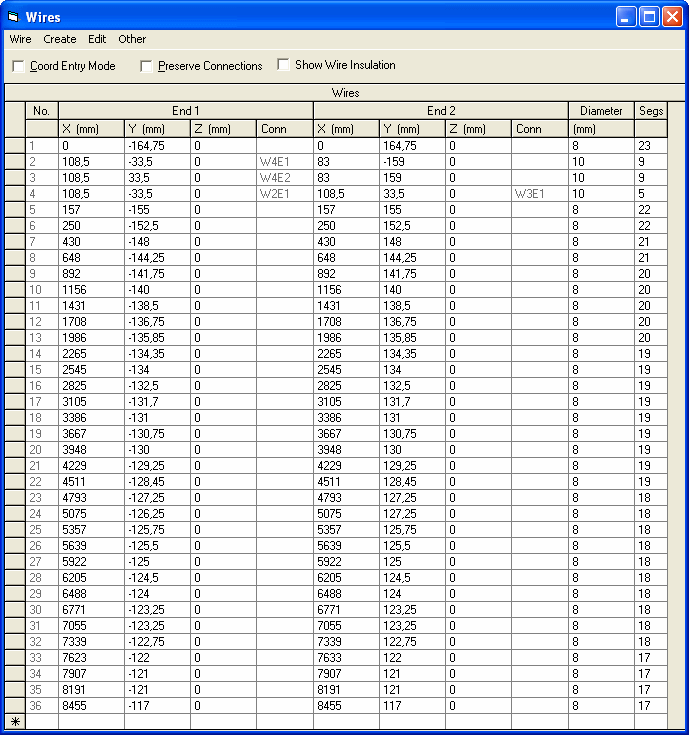
The Drivers diameter is 10 mm for all examples.
Use EZNEC's Auto-Segmentation at 1050 MHz.
A simple symmetrising member may be made from a 3 x 1/4 Lambda line grounded at the far side with
N-flange-bushing and an aluminium plate and ferrite added as close as possible to the DE, see below.
How many OMs have been looking up this design?

Geometry
Ø8 mm Elements - On Boom - Dimensions (BC acc. DG7YBN) 
Actual BC for on a 25 x 25 mm Boom with standard insulators is 11.0 mm, SBC is 1.37 mm,
total length to add is ~ 12.4 mm

Using a large calliper gauge to control element lenghts to a 10th of a millimeter is a must.

Pattern and VSWR Plots
Elevation and Azimuth plot at 432.1 MHz


SWR and Return Loss plots - simulated with 4nec2
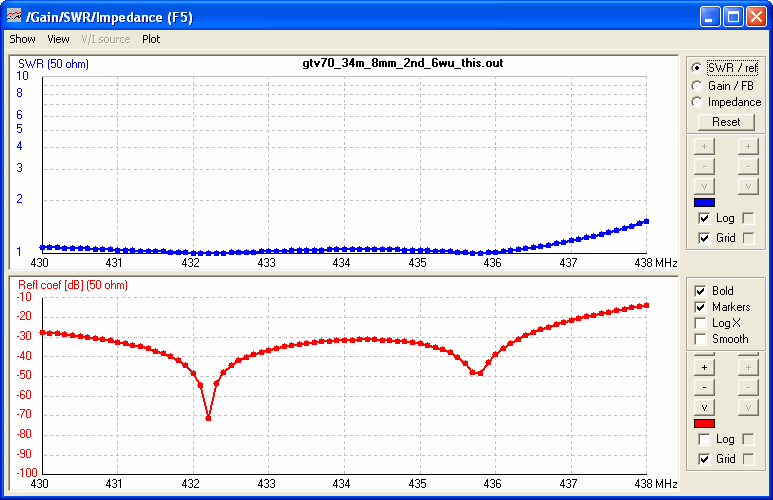

Stacking
As on the 432 MHz Band the Y-factor = T_earth / T_sky is that high I see little chances in
bettering an array's RX performance by using "Over Stacking" distances. However, depending
the level of local QRM it might be worthwhile to try less distance, especially in H-plane.

Stacking Dist. DL6WU Formula
H-plane 2.00 m
E-plane 2.04 m
Elevation and Azimuth plot and data of 4 Yagi bay using DL6WU stacking distances
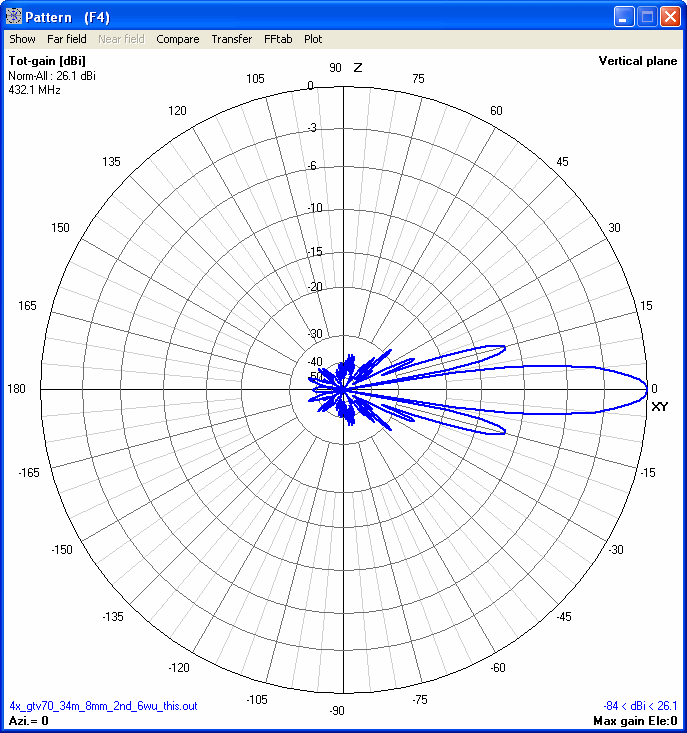

AGTC_lite screenshot of this Yagi with 8 mm elements

Gain vs. isotr. Rad. 26.10 dBi
Gain vs. Dipole 23.95 dBD
-3 dB H-plane, appr. -.- deg.
-3 dB E-plane, appr. -.- deg.
F/B -.- dB
F/R -.- dB
T_ant 26.2 K*
G/T 11.91 dB*
Theoretical numbers, no phasing line losses
nor imperfections caused by H-frame included
*) T_sky = 20 K, T_earth = 350 K as in VE7BQH G/T table

Symmetrising 50 to 50 ohms Feedline to 432 MHz Bent DE
The principle is similar to the 1/4 Lambda coax. Adding 2 x 1/4 Lambda or a half wave line does not change anything but allows
to form a gentle bow below the boom or until behind the Reflector. Follow practical construction hints on "Building a Yagi" page.

 Attenzione!
Take care when lengthening the coax, measure the right length instead of refering to given v-factors only. Attenzione!
Take care when lengthening the coax, measure the right length instead of refering to given v-factors only.
A good choice may be the diam. 5 mm PTFE coax RG-142 B/U: real resonate length (432.2 Mhz as 3/4 Lambda) shield-shield is around 348 mm
 Find more information on Phasing & Matching Lines page Find more information on Phasing & Matching Lines page 

73, Hartmut, DG7YBN

|
|















 Attenzione!
Take care when lengthening the coax, measure the right length instead of refering to given v-factors only.
Attenzione!
Take care when lengthening the coax, measure the right length instead of refering to given v-factors only. Find more information on Phasing & Matching Lines page
Find more information on Phasing & Matching Lines page 























